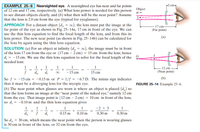
College Physics
11th Edition
ISBN: 9781305952300
Author: Raymond A. Serway, Chris Vuille
Publisher: Cengage Learning
expand_more
expand_more
format_list_bulleted
Concept explainers
Question
About how much longer is the nearsighted eye in
Example 25–6 than the 2.0 cm of a normal eye?

Transcribed Image Text:EXAMPLE 25-6 Nearsighted eye. A nearsighted eye has near and far points
of 12 cm and 17 cm, respectively. (a) What lens power is needed for this person
to see distant objects clearly, and (b) what then will be the near point? Assume
that the lens is 2.0 cm from the eye (typical for eyeglasses).
APPROACH For a distant object (d, = 0), the lens must put the image at the
far point of the eye as shown in Fig. 25–14a, 17 cm in front of the eye. We can
use the thin lens equation to find the focal length of the lens, and from this its
lens power. The new near point (as shown in Fig. 25–14b) can be calculated for
the lens by again using the thin lens equation.
SOLUTION (a) For an object at infinity (d, = 0), the image must be in front
of the lens 17 cm from the eye or (17 cm – 2 cm) = 15 cm from the lens; hence
d; = -15 cm. We use the thin lens equation to solve for the focal length of the O
2 cm
Object
at oo
I•<=
17 cm-
(Far point)
(a)
needed lens:
1
1
+
do
1
12 cm -
(Near point)
di
-15 cm
15 cm
So f = -15 cm = -0.15 m or P = 1/f = -6.7 D. The minus sign indicates
that it must be a diverging lens for the myopic eye.
(b) The near point when glasses are worn is where an object is placed (d.) so
that the lens forms an image at the "near point of the naked eye," namely 12 cm
from the eye. That image point is (12 cm – 2 cm) = 10 cm in front of the lens,
so d; = -0.10 m and the thin lens equation gives
(b)
FIGURE 25-14 Example 25–6.
1
1
0.30 m
1
1
1
1
-2 + 3
d.
di
0.15 m
0.10 m
0.30 m
So d, = 30 cm, which means the near point when the person is wearing glasses
is 30 cm in front of the lens, or 32 cm from the eye.
Expert Solution
This question has been solved!
Explore an expertly crafted, step-by-step solution for a thorough understanding of key concepts.
This is a popular solution
Trending nowThis is a popular solution!
Step by stepSolved in 2 steps

Knowledge Booster
Learn more about
Need a deep-dive on the concept behind this application? Look no further. Learn more about this topic, physics and related others by exploring similar questions and additional content below.Similar questions
- (a) If your relaxed eye has a refractive power of 55.1 D, and your lens-to-retina distance is 2.35 cm, determine if you are near or far sighted.nearsightedfarsighted (b) If you are nearsighted, determine your far point. If you are farsighted, determine your near point.cmarrow_forwardA nearsighted man wears contact lenses of -3.00 diopters. With these lenses, his corrected near point is 25.0 cm. What is his uncorrected near point?arrow_forwardIf a person with myopia has a near point of 15cm without glasses and wears a corrective lens of -1.0 D, what is the near point when the person is wearing glasses?arrow_forward
- Problem 12: A student wears eyeglasses of power P = -3.75 diopter to correct nearsightedness. The glasses are designed to be worn d = 1.3 cm in front of the eye. Part (a) Input an expression for the far point the student can see without correction, do. Part (b) Numerically, what is the distance in meters?arrow_forwardDuring LASIK eye surgery (laser - assisted in situ keratomileusis), the shape of the cornea is modified by vaporizing some of its material. If the surgery is performed to correct for nearsightedness, how does the cornea need to be reshaped?arrow_forwardQuestion is belowarrow_forward
- What is the far point and near point of the human eye with normal vision?arrow_forwardWhy would you anticipate a spectacle lens of roughly 16 D to be given if the lens of a person's eye is removed due to cataracts?arrow_forwardA person uses corrective glasses of power -8.5 D. (a) Is this person nearsighted or farsighted? (b) If the glasses are worn 2.0 cm from the eye, what is the person's far point without glasses?arrow_forward
arrow_back_ios
arrow_forward_ios
Recommended textbooks for you
 College PhysicsPhysicsISBN:9781305952300Author:Raymond A. Serway, Chris VuillePublisher:Cengage Learning
College PhysicsPhysicsISBN:9781305952300Author:Raymond A. Serway, Chris VuillePublisher:Cengage Learning University Physics (14th Edition)PhysicsISBN:9780133969290Author:Hugh D. Young, Roger A. FreedmanPublisher:PEARSON
University Physics (14th Edition)PhysicsISBN:9780133969290Author:Hugh D. Young, Roger A. FreedmanPublisher:PEARSON Introduction To Quantum MechanicsPhysicsISBN:9781107189638Author:Griffiths, David J., Schroeter, Darrell F.Publisher:Cambridge University Press
Introduction To Quantum MechanicsPhysicsISBN:9781107189638Author:Griffiths, David J., Schroeter, Darrell F.Publisher:Cambridge University Press Physics for Scientists and EngineersPhysicsISBN:9781337553278Author:Raymond A. Serway, John W. JewettPublisher:Cengage Learning
Physics for Scientists and EngineersPhysicsISBN:9781337553278Author:Raymond A. Serway, John W. JewettPublisher:Cengage Learning Lecture- Tutorials for Introductory AstronomyPhysicsISBN:9780321820464Author:Edward E. Prather, Tim P. Slater, Jeff P. Adams, Gina BrissendenPublisher:Addison-Wesley
Lecture- Tutorials for Introductory AstronomyPhysicsISBN:9780321820464Author:Edward E. Prather, Tim P. Slater, Jeff P. Adams, Gina BrissendenPublisher:Addison-Wesley College Physics: A Strategic Approach (4th Editio...PhysicsISBN:9780134609034Author:Randall D. Knight (Professor Emeritus), Brian Jones, Stuart FieldPublisher:PEARSON
College Physics: A Strategic Approach (4th Editio...PhysicsISBN:9780134609034Author:Randall D. Knight (Professor Emeritus), Brian Jones, Stuart FieldPublisher:PEARSON

College Physics
Physics
ISBN:9781305952300
Author:Raymond A. Serway, Chris Vuille
Publisher:Cengage Learning

University Physics (14th Edition)
Physics
ISBN:9780133969290
Author:Hugh D. Young, Roger A. Freedman
Publisher:PEARSON

Introduction To Quantum Mechanics
Physics
ISBN:9781107189638
Author:Griffiths, David J., Schroeter, Darrell F.
Publisher:Cambridge University Press

Physics for Scientists and Engineers
Physics
ISBN:9781337553278
Author:Raymond A. Serway, John W. Jewett
Publisher:Cengage Learning

Lecture- Tutorials for Introductory Astronomy
Physics
ISBN:9780321820464
Author:Edward E. Prather, Tim P. Slater, Jeff P. Adams, Gina Brissenden
Publisher:Addison-Wesley

College Physics: A Strategic Approach (4th Editio...
Physics
ISBN:9780134609034
Author:Randall D. Knight (Professor Emeritus), Brian Jones, Stuart Field
Publisher:PEARSON